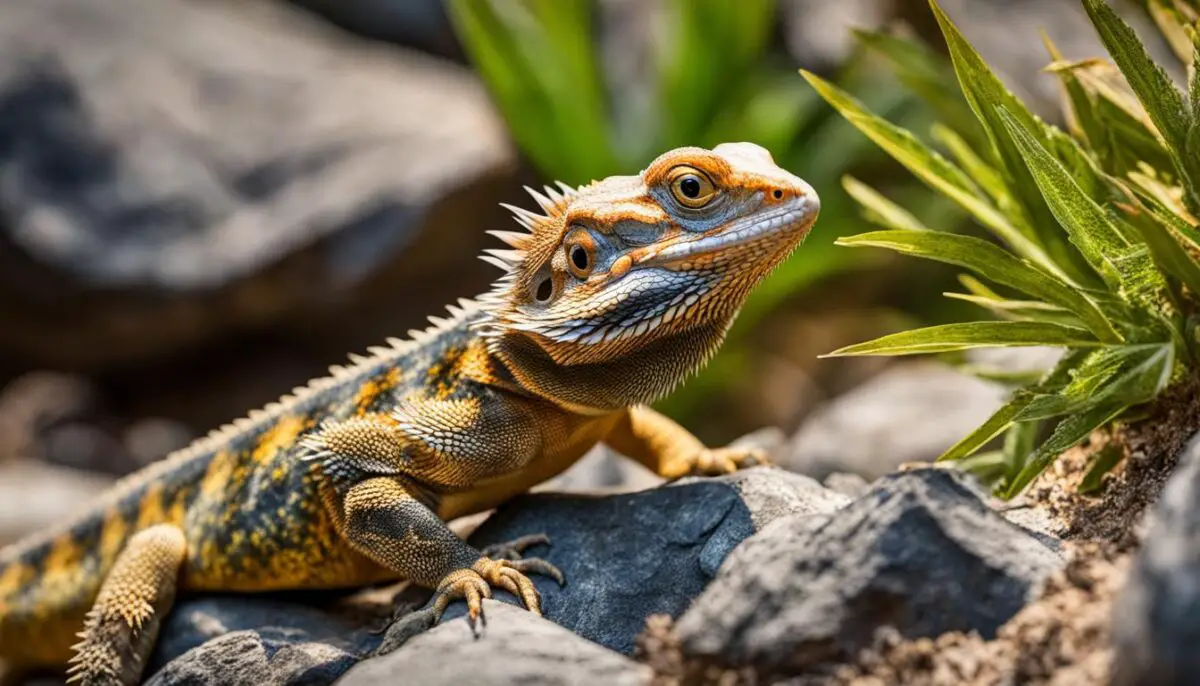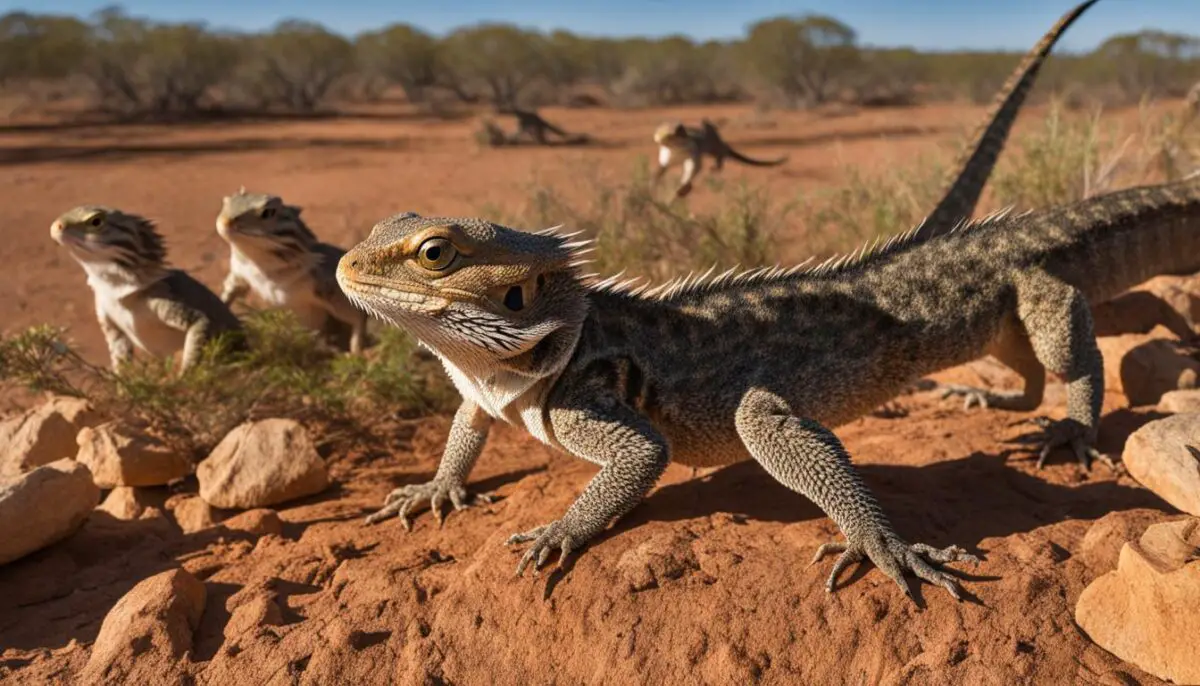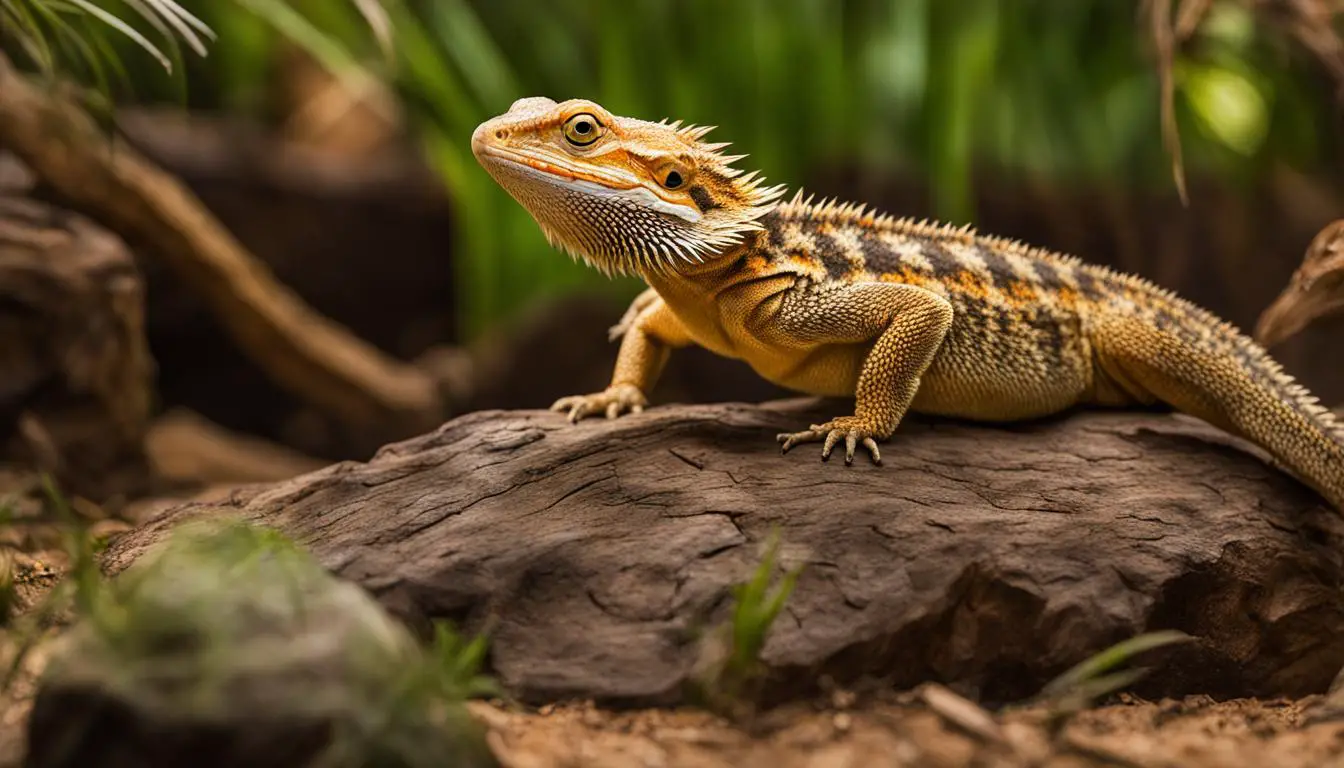Bearded dragons are fascinating reptiles native to Australia. While they may seem harmless and docile, they have a number of natural enemies in their habitat. Understanding these predators is crucial for ensuring the safety and well-being of bearded dragons, both in the wild and as pets.
In their natural environment, bearded dragons face threats from various predators. Goannas, snakes, hawks, dingoes, and even other bearded dragons can pose a danger to these reptiles. Predators can significantly impact the survival and population of bearded dragons, making it essential to be aware of the risks they face.
Even in captivity, bearded dragons may exhibit cannibalistic behavior and consume other individuals of their species. This highlights the importance of providing a secure and suitable habitat for these pets.
Key Takeaways:
- Bearded dragons have several predators in their natural habitat, including goannas, snakes, hawks, dingoes, and other bearded dragons.
- Predators pose a significant threat to the safety and well-being of bearded dragons, both in the wild and as pets.
- Understanding the predators that bearded dragons face can help pet owners take appropriate measures to protect them.
- Creating a secure enclosure and providing a safe environment is crucial for safeguarding bearded dragons from predators.
- Regular monitoring and taking preventive actions can help minimize the risk of predation on pet bearded dragons.
By being aware of the threats that bearded dragons face and taking necessary precautions, we can ensure that these remarkable reptiles thrive and live a long, happy life.
Natural Defenses of Bearded Dragons
Bearded dragons are equipped with various defense mechanisms to safeguard themselves against potential predators. These strategies help them survive in their natural habitat and ensure their safety as pets. Let’s explore the fascinating defenses of these captivating reptiles:
Beard Display:
One notable defense mechanism of bearded dragons is their ability to flare up their beard. This beard is a specialized patch of scales located under their chin, which they can inflate when threatened. By puffing up their beard, they create an illusion of larger size, intimidating potential predators and making them think twice before approaching.
Mouth Gaping and Displays:
Another defensive behavior exhibited by bearded dragons is gaping, where they open their mouths wide, revealing their beard as a warning sign. This act not only highlights the impressive coloration of their beard but also serves as a visual threat. By showcasing their beard, bearded dragons communicate their ability and willingness to defend themselves.

Bite:
While bearded dragons are generally docile, they have the capability to bite when necessary. Although biting is not their primary defense, they may resort to this action as a last resort to protect themselves from immediate danger. The bite force of a bearded dragon is impressive, further enhancing their defense against predators.
Physical Appearance:
Bearded dragons possess physical attributes that enhance their defense mechanisms. Their spiky body and flattened appearance make them visually intimidating and less vulnerable to potential attackers. The spikes on their body act as a physical deterrent, making it difficult for predators to grasp or swallow them.
By combining these defense mechanisms, bearded dragons have an impressive array of tools to protect themselves in their natural habitat. Their ability to adapt and employ these tactics showcases their survival instincts and resilience.
Bearded Dragon Defense Mechanisms
| Defense Mechanism | Description |
|---|---|
| Beard Display | Flaring up the beard to appear larger and more intimidating. |
| Mouth Gaping and Displays | Opening their mouths wide to showcase their beard and warn predators. |
| Bite | Utilizing their strong jaws to bite potential threats. |
| Physical Appearance | Having a spiky and flattened body, making it challenging for predators to handle them. |
Through these defense mechanisms, bearded dragons have evolved to ward off predators, making them fascinating creatures to observe and care for.
Camouflage and Adaptations
Bearded dragons are masterful at blending into their surroundings through their remarkable camouflage and adaptations. Their coloration is perfectly suited to the environment they inhabit, allowing them to blend seamlessly into their surroundings. The bumps and spikes on their bodies further aid in breaking up their silhouette, making them less visible to potential predators.
Let’s take a closer look at the fascinating features that contribute to the bearded dragon’s camouflage and survival.
Coloration: Matching their Habitat
Bearded dragons exhibit a wide range of color variations, which help them blend in with their habitat. Their coloration can range from shades of brown, tan, green, and even yellow. This remarkable ability to match their surroundings ensures that they remain hidden from predators, providing them a higher chance of survival.
Spikes and Bumps: Disrupting Silhouette
The bearded dragon’s body is adorned with spikes and bumps that help to break up their silhouette. These spikes not only make them look more intimidating but also serve as a defensive adaptation. The irregular texture of their skin further aids in their camouflage, making it difficult for predators to identify them from a distance.
Bearded dragons’ spikes and bumps not only contribute to their camouflage but also play a crucial role in their defense mechanism. When threatened, a bearded dragon can puff up its body and extend its spikes, making it appear larger and more dangerous to potential predators.
While camouflage and adaptations are effective strategies for avoiding detection by many predators, they are not foolproof. Predators with a keen sense of smell or those birds that can spot their movement from above may still pose a significant threat to bearded dragons.
Understanding the bearded dragon’s remarkable abilities to blend in with their environment and their unique adaptations is key to appreciating their survival skills in the wild.

A bearded dragon blending into its natural habitat through camouflage.
Bearded Dragon Camouflage Features
| Camouflage Feature | Description |
|---|---|
| Coloration | Variations in color help bearded dragons match their habitat and go unnoticed by predators. |
| Spikes and Bumps | Irregular textures disrupt the silhouette, making it harder for predators to detect bearded dragons. |
| Body Puffing | Bearded dragons can puff up their bodies and extend their spikes as a defensive display. |
Defensive Behaviors
Bearded dragons have developed various defensive behaviors to protect themselves from threats and potential predators. These behaviors include gaping, biting, and body flattening.
Gaping: When a bearded dragon feels threatened, it will open its mouth wide to display its beard. This behavior is known as gaping and serves as a warning to potential predators. By showcasing their beards, bearded dragons try to intimidate and discourage predators from attacking.
Biting: Bearded dragons may resort to biting if they perceive a predator or a rival lizard as a direct threat. With their sharp teeth and jaws, they can deliver a powerful bite as a means of defense. Biting is a last resort for bearded dragons, but it can be an effective deterrent against potential attackers.
Body Flattening: When faced with a predator, bearded dragons have the ability to flatten their bodies. By spreading out their legs and pressing their bodies close to the ground, they create a larger appearance that can be intimidating to predators. This defensive posture, coupled with their spiky body texture, serves as a visual signal to potential threats to back off.

Bearded dragons are well-adapted to their environment, but they are not invincible. Predators play a crucial role in the ecosystem and are an integral part of the natural balance. Understanding the predators of bearded dragons can help us appreciate the challenges these reptiles face in the wild.
Goannas
Goannas are one of the most common predators of bearded dragons. These large monitor lizards are skilled climbers and hunters. They have sharp claws and powerful jaws, making them a formidable threat to bearded dragons.
Snakes
Snakes, such as brown snakes and carpet pythons, are another natural enemy of bearded dragons. They are stealthy predators that rely on their strong sense of smell to locate their prey. Bearded dragons must be cautious to avoid falling victim to these slithering hunters.
Birds of Prey
Birds of prey, like hawks and owls, have keen eyesight and sharp talons. They can spot bearded dragons from above and swoop down to snatch them up. The ability to camouflage and exhibit defensive behaviors, such as flattening their bodies, can help bearded dragons evade these aerial predators.
Dingoes
Dingoes, wild dogs native to Australia, are also known to prey on bearded dragons. They are cunning hunters that can quickly overpower their prey. Bearded dragons must rely on their defensive strategies to avoid becoming a meal for these formidable canines.
Other Bearded Dragons
Surprisingly, bearded dragons themselves can be predators of their own kind. When resources are scarce, cannibalism may occur, with larger individuals preying on smaller or weaker ones. This behavior highlights the harsh realities of survival in the wild.
Despite the existence of these predators, bearded dragons have evolved various defense mechanisms, including camouflage, defensive behaviors like gaping and biting, and physical adaptations that help them survive in their natural environment.
| Bearded Dragon Predators | Threat Level | Description |
|---|---|---|
| Goannas | High | Skilled climbers and hunters with sharp claws and powerful jaws. |
| Snakes | Moderate | Stealthy predators with a strong sense of smell. |
| Birds of Prey | Moderate | Keen eyesight and sharp talons for aerial hunting. |
| Dingoes | Moderate | Cunning wild dogs that can overpower their prey. |
| Other Bearded Dragons | Low | Cannibalistic behavior when resources are scarce. |
Protecting Bearded Dragons from Predators
As pet owners, it is our responsibility to ensure the safety and well-being of our beloved bearded dragons. Protecting them from predators is crucial to their health and longevity. By implementing a few simple measures, we can safeguard our bearded dragons and provide them with a secure environment.
Create a Predator-Proof Enclosure
One of the most effective ways to protect bearded dragons is by providing them with a secure enclosure. Using wire mesh with small enough openings can prevent access from snakes and other potential predators. Ensure that the enclosure has a sturdy construction and is free from any gaps or openings that may allow predators to enter.
Eliminate Potential Hazards
It is important to identify and eliminate any potential dangers within the bearded dragon’s habitat. Remove any poisonous plants that may pose a threat to their health. Avoid using insecticides or pesticides near the enclosure as they can be harmful if ingested. Keep the habitat clean and free from debris to minimize hiding places for predators.
Regular Monitoring
Regularly monitoring the bearded dragon’s enclosure is essential to detect any signs of predators or other potential risks. Inspect the enclosure for any damages or vulnerabilities that may need immediate attention. Keep an eye out for signs of intrusion from snakes, birds, or other animals that may be a threat to the safety of your bearded dragon.
“By providing a safe environment, we can protect our bearded dragons from the dangers they may face.”
Remember that prevention is key when it comes to protecting bearded dragons from predators. Taking these proactive measures can ensure the well-being and safety of our reptilian companions. Let’s create a secure and nurturing environment for our bearded dragons so they can thrive and live a long, healthy life.
Conclusion
Bearded dragons, like other reptiles, face numerous threats from predators in their natural habitat. Some of the main predators that pose a risk to bearded dragons include goannas, snakes, birds of prey, dingoes, and other bearded dragons. Understanding these natural enemies is crucial for protecting these captivating creatures.
To safeguard bearded dragons, it is essential to create a safe and secure environment. As responsible pet owners, we can provide them with a predator-proof enclosure, using wire mesh and other measures to prevent access by snakes and other potential threats. Regular monitoring ensures that their habitat is free from dangers such as toxic plants or harmful pesticides.
By implementing these preventive measures, we can protect bearded dragons from the risks posed by their natural predators. Whether they are kept as pets or observed in the wild, bearded dragons deserve our care and attention to ensure their well-being and longevity.
FAQ
What are the natural enemies of bearded dragons?
Bearded dragons have several predators in their natural habitat, including goannas, snakes, hawks, and dingoes. They may also consume other bearded dragons, exhibiting cannibalistic behavior in captivity.
How do bearded dragons defend themselves against predators?
Bearded dragons have several defense mechanisms to protect themselves. They can flare up their well-adapted beard to appear larger and more intimidating. They also use gaping, opening their mouths to display their beards as a threat. Additionally, they can bite, use their spiky body, and flatten their appearance to deter predators.
Do bearded dragons have camouflage to hide from predators?
Yes, bearded dragons have built-in camouflage. Their coloration matches their habitat, and the bumps and spikes on their bodies help break up their silhouette. However, camouflage may not be effective against predators that rely on smell or birds that spot them from above.
What defensive behaviors do bearded dragons exhibit?
When threatened, bearded dragons commonly display gaping, where they open their mouths to display their beards, signaling a potential threat. They may also bite if a predator or rival lizard gets too close. Additionally, they can flatten their bodies to appear larger and more intimidating.
What are the common predators of bearded dragons in the wild?
Bearded dragons face a range of predators in the wild, including goannas, snakes, birds of prey, dingoes, and even other bearded dragons. These natural enemies pose a significant threat to their survival.
How can I protect my pet bearded dragon from predators?
To protect your pet bearded dragon, it is important to provide a secure enclosure that is predator-proof, using wire mesh to prevent access from snakes and other predators. Ensuring a safe environment free from potential dangers, such as poisonous plants or insecticides, is also crucial. Regular monitoring and creating a safe habitat can help prevent predation on pet bearded dragons.

